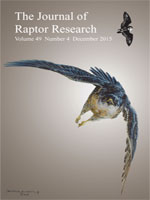In some urban environments, human activities enhance resources for avian species, providing habitat that can support year-round occupancy. If both members of a mated pair stay on their breeding territories year-round, close proximity of pair members throughout the year may increase the potential for interactions outside the breeding season. Under these circumstances, avian species that would otherwise terminate their bonds following the breeding season may form perennial pair bonds. We examined behavior of mated pairs of adult Cooper’s Hawks (Accipiter cooperii) during the nonbreeding season in an urban environment to determine whether pairs retained their breeding territories outside the breeding season and if year-round maintenance of territories influenced the duration of pair bonds. Home ranges and core areas of pair members largely overlapped. Pair members remained close to the nest site they used during the previous breeding season, avoided neighboring conspecifics of the same sex, and selected areas within their home ranges that supported abundant avian prey and contained vertical vegetation structure. Pair members interacted throughout the nonbreeding season via acts of courtship and vocalizations, mainly in areas near the nest site. Perennial pair bonds in Cooper’s Hawks in this urban environment are likely a response to high availability of prey throughout the year and facilitated largely by fidelity to and retention of all-purpose territories year-round. For Cooper’s Hawks in this urban environment, maintaining pair bonds continuously may confer several advantages such as early initiation of breeding and higher reproductive success.
How to translate text using browser tools
1 December 2015
Perennial Pair Bonds in an Accipiter: A Behavioral Response to an Urbanized Landscape?
Matthew A. Boggie,
R. William Mannan,
Craig Wissler

Journal of Raptor Research
Vol. 49 • No. 4
December 2015
Vol. 49 • No. 4
December 2015
Accipiter
Accipiter cooperii
Cooper’s Hawk
habitat selection
pair bonds
social behavior
space use




